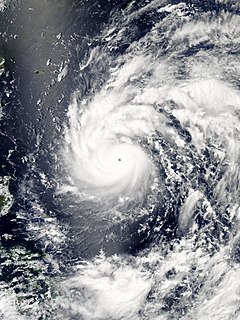The name Hanna or Hannah has been used for eleven tropical cyclones worldwide: five in the Atlantic Ocean and six in the Western Pacific Ocean. Hanna has also been used for one extratropical European windstorm.
The name Gilda has been used for three tropical cyclones in the Atlantic Ocean, nine in the western Pacific Ocean, and one in the southwest Indian Ocean.

Typhoon Haitang, known in the Philippines as Typhoon Feria, was the first super typhoon of the 2005 season in the northwestern Pacific. It had winds up to 260 km/h (160 mph) at peak intensity, and caused over 18 serious injuries and 13 confirmed deaths in Taiwan and People's Republic of China. Damage totaled about $1.1 billion (2005 USD), most of which occurred in mainland China.
The name Nina has been used for thirteen typhoons in the northwest Pacific Ocean, one tropical cyclone in the northeast Pacific Ocean, and one tropical cyclone in the southwest Pacific.
The name Alice has been used for eighteen tropical cyclones worldwide: four in the Atlantic Ocean, ten in the Western Pacific Ocean, one in the South-West Indian Ocean, and three in the Australian region.
The name Isang has been used for sixteen tropical cyclones worldwide: fifteen times by the Philippine Atmospheric, Geophysical and Astronomical Services Administration (PAGASA) in the Western Pacific, and once by the Météo-France in the South-West Indian Ocean.
The name Agnes has been used for a total of sixteen tropical cyclones worldwide: one in the Atlantic Ocean, thirteen in the Western North Pacific Ocean, one in the South-West Indian Ocean, and one in the South Pacific Ocean.
The name Butchoy has been used for five northwestern Pacific Ocean tropical cyclones within the Philippine Area of Responsibility.

The 2016 Pacific typhoon season is considered to have been the fourth-latest start for a Pacific typhoon season since reliable records began. It was an average season, with a total of 26 named storms, 13 typhoons, and six super typhoons. The season ran throughout 2016, though typically most tropical cyclones develop between May and October. The season's first named storm, Nepartak, developed on July 3, while the season's last named storm, Nock-ten, dissipated on December 28.

Typhoon Nepartak, known in the Philippines as Typhoon Weng, was a modest tropical cyclone that struck the central Philippines and the southern China island of Hainan in November 2003. Forming as a tropical depression on November 11 between Yap and Guam, the system moved westward and slowly intensified. It received the name Nepartak midday on November 12 from the Japan Meteorological Agency, becoming the 20th named storm of the 2003 Pacific typhoon season. On November 13, Napartak struck Samar in the Philippines and bisected the island chain. Up to four million people lost power, and transportation ground to a halt; over 5,000 individuals became stranded on ships forced to stay in port during the tropical storm. It was reported that 13 individuals died in the storm in the Philippines.

This timeline documents all of the events of the 2016 Pacific typhoon season. Most of the tropical cyclones forming between May and November. The scope of this article is limited to the Pacific Ocean, north of the equator between 100°E and the International Date Line. Tropical storms that form in the entire Western Pacific basin are assigned a name by the Japan Meteorological Agency. Tropical depressions that form in this basin are given a number with a "W" suffix by the United States' Joint Typhoon Warning Center. In addition, the Philippine Atmospheric, Geophysical and Astronomical Services Administration (PAGASA) assigns names to tropical cyclones that enter or form in the Philippine area of responsibility. These names, however, are not in common use outside of the Philippines.

Typhoon Nepartak, known in the Philippines as Typhoon Butchoy, was the third most intense tropical cyclone worldwide in 2016. Nepartak severely impacted Taiwan and East China, with 86 confirmed fatalities. It caused 3 deaths and NT$678 million of damage in Taiwan. Moreover, Nepartak also had disastrous effects in Fujian, China, causing 111 deaths and ¥9.99 billion of damage. After the season, total damages exceeded up to ¥12.65 billion.

The 2021 Pacific typhoon season was a below-average season that produced a total of 22 named storms, the least since 2011, 9 typhoons, and five super typhoons. The season's first named storm, Dujuan, developed on February 16, while the last named storm, Rai, dissipated on December 21. The season's first typhoon, Surigae, reached typhoon status on April 16. It became the first super typhoon of the year on the next day, also becoming the strongest tropical cyclone in 2021. Surigae was also the most powerful tropical cyclone on record in the Northern Hemisphere for the month of April. Typhoons In-fa and Rai are responsible for more than half of the total damage this season, adding up to a combined total of $2.017 billion.
The name Heling was used for nine tropical cyclones in the Philippines by PAGASA in the Western Pacific Ocean.
The name Gading was used for nine tropical cyclones in the Philippines by PAGASA in the Western Pacific Ocean.
The name Bining was used for nine tropical cyclones by the Philippine Atmospheric, Geophysical and Astronomical Services Administration (PAGASA) in the Western Pacific Ocean.
The name Luding was used for ten tropical cyclones by the Philippine Atmospheric, Geophysical and Astronomical Services Administration (PAGASA) and its predecessor, the Philippine Weather Bureau, in the Western Pacific Ocean.
This page is based on this
Wikipedia article Text is available under the
CC BY-SA 4.0 license; additional terms may apply.
Images, videos and audio are available under their respective licenses.




